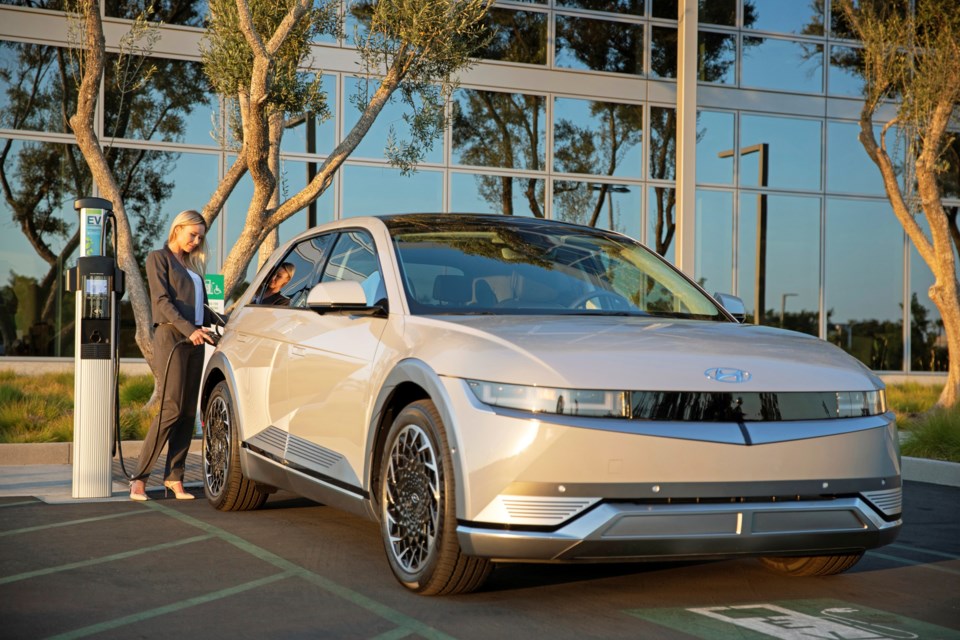Electric vehicles, or EVs for short, have been the hot car commodity for 2022. Their sales were up nearly 82% from 2021 and now make up 5% of the total market, according to Edmunds data. But many prospective buyers have about this new technology. With this in mind, here are answers to the top questions that EV shoppers at Edmunds want to know .
HOW MANY MILES CAN YOU DRIVE ON A FULL CHARGE?
Your range will be determined by the EV model, the size of its battery, the ambient temperature, your driving style and your wallet. There’s the Mazda MX-30 and its 100-mile range on the low end and the six-figure Lucid Air Grand Touring with up to 516 miles on the other. A ballpark average for today’s EVs would be around 250 miles. Older EVs will have less range, roughly 100-200 miles, due to being first-generation technology and battery degradation.
Your driving habits will greatly affect how far you can go, just as they would on a gas-powered vehicle. Accelerate slowly and smoothly and you’ll go farther. Driving aggressively and maintaining high speeds will eat into your range. Edmunds conducts its own real-world EV range testing, which can be helpful in getting a more realistic estimate.
HOW MANY YEARS WILL THE BATTERY LAST?
Battery life is determined by how often the battery was exposed to extreme temperatures, how often it operated at high and low states of charge, how many charge cycles it received, and how many times it visited a DC fast charger.
Like your smartphone’s battery, an EV battery’s performance will degrade over the years, albeit much slower. After 10 years, your EV’s battery would have a charge of roughly 77%, according to vehicle data company Geotab.
To alleviate some of this concern, the federal government has mandated that all EV batteries be covered for at least eight years or 100,000 miles, whichever comes first. In California and the 14 other states that have adopted its zero-emissions vehicle regulations, the coverage is extended to 10 years.
DOES IT QUALIFY FOR A TAX CREDIT?
has changed since the Inflation Reduction Act was passed. As of this writing, to qualify for a tax credit, a new EV must be assembled in North America. This gets you a $7,500 nonrefundable tax credit on your 2022 return. Next year, this part of the equation will net you $3,750.
Starting in 2023, there will be price limits on top of the final assembly requirements. Eligible SUVs, vans and pickup trucks will have a price cap of $80,000. Sedans and other vehicles will be capped at $55,000. Yet another requirement looks at the modified adjusted gross income of the buyer. Finally, there is the EV battery component requirement, which states that 50% of the EV components must be sourced, manufactured or assembled in the U.S. or in any country that it has a free trade agreement with. That percentage will go up in subsequent years.
HOW LONG DOES IT TAKE TO CHARGE?
The time it takes to charge an EV depends on its battery size, the speed of its onboard charger (usually rated in kilowatts), and the voltage of where you plug it in. For daily driving and commuting, most people will be able to charge overnight at a 240-volt socket, also called Level 2 charging. It would take significantly longer to charge an EV on a standard 110-volt wall socket. A Level 3 or DC fast charger would be needed for road trips. These high-power stations significantly reduce charging time, and in general, a vehicle can go from a 10% to 80% charge in about 30 minutes.
WHERE AND WHEN ARE THEY AVAILABLE?
Many EVs are available at your local dealership. However, there’s been a shortage of new cars in recent years, and EVs have been hit the hardest due to their complexity. You might need to get on a waiting list or be prepared to pay a premium, as some zealous dealerships have saddled them with accessories or a flat markup.
Startup brands such as Tesla, Lucid and Rivian exist outside the dealer system and sell directly to consumers on their websites. They rarely carry inventory, and cars are often built after an order is placed. Depending on the vehicle model and configuration, it can take anywhere from a few weeks to upwards of a year.
EDMUNDS SAYS: Electric vehicles do have a learning curve and require a bit more forethought about your destinations, but that shouldn’t put you off purchasing one. The more you research and learn, the less intimidating an EV will be.
_______
This story was provided to by the automotive website .
is a senior consumer advice editor at Edmunds.
Ronald Montoya, The Associated Press




